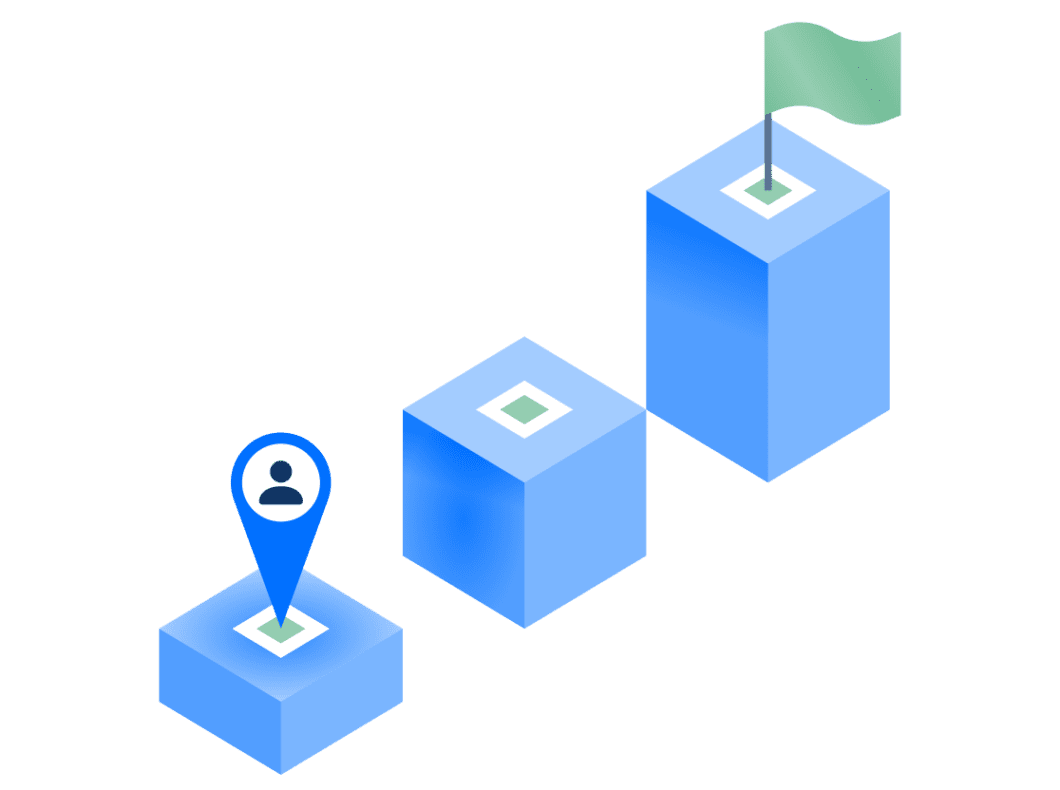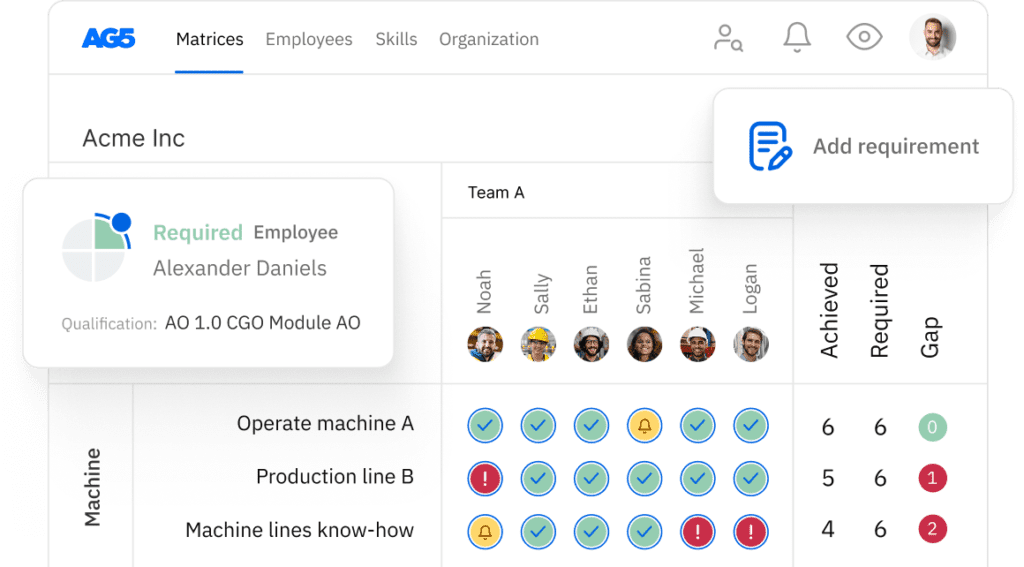What is reskilling: Benefits & how to reskill your workers
In this article, we discuss the imperative of reskilling the workforce, as projected that 50% of employees will require reskilling by 2025. It emphasizes the significance and strategies for effective reskilling initiatives.

What is reskilling?Copied
Reskilling is the process of training employees in entirely new skills to transition into different roles within the organization.
This is different from simply upgrading current capabilities; reskilling means preparing your workforce for new responsibilities altogether, often in response to automation, business model shifts, or compliance mandates.
Reskilling has become a strategic priority for organizations facing rapid technological change and skills obsolescence.
Whether due to AI adoption, regulatory updates, or evolving job functions, certain roles are phasing out while new ones emerge just as quickly. In this context, reskilling ensures continuity, agility, and workforce relevance.
Consider an assembly-line worker trained to operate advanced robotics. Or a compliance assistant shifting toward data privacy analysis.
These aren’t just lateral moves. They also represent a leap into future-ready capabilities that drive value.
What sets reskilling apart is its dual benefit: it retains valuable institutional knowledge while opening doors to entirely new operational potential.
The result? A workforce that grows alongside the business, rather than being left behind.
Understand the tools that support this shift in our guide to skills management software.
Reskilling vs. upskillingCopied
Reskilling prepares people for new jobs; upskilling sharpens them for their current ones.
It’s a critical distinction, especially for HR and L&D leaders aligning talent strategy with business transformation.
Let’s break it down:
- Upskilling means enhancing existing skills. For instance, a safety officer learning new audit protocols or an operations lead mastering a more advanced reporting tool.
- Reskilling, on the other hand, enables a move across functions. Imagine a maintenance technician becoming a compliance coordinator. Different skillsets. New workflows.
| Category | Upskilling | Reskilling |
|---|---|---|
| Focus | Deepening current skills | Learning new skill sets for new roles |
| Example | Project manager learning AI tools | Factory worker becoming QA inspector |
| Outcome | Greater productivity in same role | Role transition and redeployment |
Why does this matter?
Because reskilling is proactive workforce planning. It’s what keeps your organization ahead of regulatory changes, technological disruptions, or staffing shortages.
By contrast, relying solely on upskilling can leave skill gaps unaddressed when roles evolve or vanish.
A complete reskilling strategy often starts with competency gap analysis, identifying where entirely new skills are needed.
Why reskilling matters now?Copied
Reskilling is a now problem. According to the World Economic Forum, 44% of workers’ core skills are expected to change by 2027.
And organizations that ignore this shift risk operational disruption, compliance failures, and rising attrition.
Key drivers accelerating the need for reskilling include:
- Automation & AI. Roles in logistics, manufacturing, and data entry are being redefined or eliminated
- Digital transformation. As systems modernize, legacy workflows vanish. Staff must adapt to cloud-based tools, analytics platforms, and new communication protocols
- Regulatory complexity: Evolving compliance standards mean roles in quality, health, and safety require continuous recalibration
- Workforce shortages: When external hiring stalls, internal talent mobility becomes essential
Reskilling is the most efficient response. It leverages the experience, loyalty, and cultural fit of your current workforce while enabling them to step confidently into new functions.
Organizations that invest in structured reskilling see gains in:
- Retention: Career progression reduces churn
- Engagement: Employees feel valued and future-proof
- Speed: Internal candidates upskill faster than onboarding outsiders
To map where these changes are needed, many companies turn to structured tools like a skills matrix or skills tracking platforms.
How technology & skill management tools accelerate reskillingCopied
Reskilling without technology is like navigating blindfolded – slow, clumsy, and full of risk.
Modern skill management platforms like AG5 turn reskilling from a chaotic manual task into a structured, data-driven strategy. Here’s how:
What technology enables
- Live skills visibility. Platforms offer real-time insight into who can do what, across teams and locations
- Gap analysis. They flag missing or declining capabilities, triggering alerts before they become risks
- Matrix building. Drag-and-drop skills matrix templates allow managers to define role-based expectations quickly
- Training alignment. Skill gaps are mapped directly to learning content via LMS integrations
- Self-service tools. Frontline staff can assess themselves, upload proof, and track progress on mobile
- Audit logs. Every certification, training, or assessment is stored and time-stamped
The result? Less guesswork. More action.
A strong skill management tool doesn’t just organize data, it also empowers decisions.
Want to reskill a warehouse team into quality inspectors? You’ll need to know who’s halfway there, who needs training, and how soon they can be redeployed.
With AG5, this happens in a single dashboard, not scattered across emails and Excel.
Reskilling for compliance & auditsCopied
In high-stakes industries like manufacturing, energy, logistics, and pharma, compliance requirements are non-negotiable.
Reskilling ensures your workforce remains both qualified and certifiable as standards shift.
Why it matters
- New regulations. Safety protocols evolve. Teams need to be quickly brought up to speed
- Role redefinition. A compliance officer may need training in digital auditing or data privacy due to new mandates
- Certification expiry. When personnel change roles, they may require new credentials. Missing one can derail an audit
With manual systems, staying ahead of these changes is nearly impossible. Certificates expire unnoticed. Training deadlines are missed. Audits turn into chaos.
Enter skill management platforms like AG5.
AG5 supports automated certificate tracking, expiry alerts, and approval workflows so that reskilled employees never fall out of compliance during or after transition.
Use case: An operations lead was reskilled into a QHSE role. AG5 linked the new skill profile to required training and scheduled compliance certifications, automatically ensuring zero gaps and full audit readiness.
Keep your workforce reskilled and certified with automated compliance oversight. Learn how to avoid audit panic with our certificate tracking tools.
Practical steps: Implementing an AG5‑powered reskilling initiativeCopied
Reskilling only works when it’s planned, tracked, and aligned with business goals. That’s where AG5 comes in.
Here’s how to run a reskilling initiative from start to finish using AG5’s skills management platform:
Step 1: Define new role profiles
Start by identifying the roles your organization will need in 6-12 months. Use AG5 to build custom skills matrices for each.
Step 2: Map current workforce capabilities
Run self-assessments and manager evaluations using AG5. The platform aggregates this data into live dashboards no spreadsheets required.
Step 3: Conduct a competency gap analysis
AG5 automatically highlights skill gaps between your current workforce and target roles. These insights are critical for targeted reskilling. Learn more about competency gap analysis.
Step 4: Align training to gaps
Link required skills to actual training modules via your LMS. AG5 syncs training assignments with skill gaps ensuring effort is focused and measurable.
Step 5: Track progress & compliance
Use automated reminders, proof uploads, and certificate logs to monitor development over time. Managers can pull reports at any moment – ideal for check-ins and audits.
Step 6: Redeploy talent
Once reskilled, employees can be reassigned or promoted with confidence. AG5’s expert finder helps match qualified staff to new roles instantly.
This structured workflow transforms reskilling from a vague goal into a predictable process, minimizing disruption and maximizing ROI.
Real-world impact & ROI evidenceCopied
Reskilling pays off in productivity, retention, and audit-readiness.
Organizations that invest in structured reskilling programs, especially with digital platforms like AG5, see tangible business outcomes. Here’s how the numbers stack up:
Operational benefits
- 70% faster role transitions Automated training alignment and gap detection accelerate workforce redeployment.
- 50% reduction in audit preparation timeCertificate tracking and compliance dashboards replace manual checks and last-minute scrambling.
- 35% drop in training costsBy focusing only on critical skills gaps, L&D budgets are used strategically.
Talent retention & morale
- Employees who see a clear path to career growth are 2.5x more likely to stay
- Internal hires through reskilling ramp up 40% faster than external recruits
Real-world example
A global logistics firm used AG5 to reskill its field techs into QA inspectors. Within 3 months:
- 82% had completed aligned training
- Audit error rates dropped by 27%
- The company saved over €200K in external hiring costs
Structured reskilling turns good HR into smart business.
Internal mobility, career paths & redeployment through reskillingCopied
Reskilling turns workforce disruption into workforce opportunity.
Hiring externally for every new need is inefficient and costly. Internal mobility, fueled by reskilling, offers a smarter path.
Why internal mobility matters
- Reduces time-to-productivity. Reskilled employees know the systems, the culture, and the workflows
- Builds loyalty. Career progression drives engagement and retention
- Maximizes existing talent. Hidden potential is surfaced and deployed strategically
AG5 makes internal mobility tangible, not theoretical.
Its expert finder and skills matrix tools help leaders:
- Spot underutilized staff ready for promotion or transition
- Map out clear career paths using live skills data
- Redeploy teams quickly in response to project or compliance demands
For example, an L&D manager can identify frontline staff who have completed key safety training and match them to open supervisory roles, all in one dashboard.
This isn’t just a benefit for HR. It’s a win for operations, compliance, and the bottom line.
Help your people grow while filling your most urgent roles; see how skills management drives internal mobility the smart way.
Looking ahead: Reskilling strategy for future workforce resilienceCopied
Reskilling is a permanent workforce capability. As roles evolve and regulatory requirements shift, organizations must build reskilling into their operating model.
That means moving from reactive training plans to proactive capability building.
Here’s what future-ready reskilling looks like:
Strategic traits
- Always-on skill tracking. Regular assessments keep capability data fresh and decision-ready
- Scenario forecasting. Use workforce data to anticipate future roles and skill gaps
- Cross-functional training. Empower employees to pivot across departments, not just grow within one
- Compliance-first planning. Build training cycles around likely audit and certification windows
- Embedded analytics. Use platform insights to fine-tune L&D spend and forecast reskilling ROI
AG5 supports this future by providing a centralized platform where skills, roles, training, and compliance all converge. It ensures that every workforce decision is informed by data.
Whether you’re responding to automation, regulation, or strategy shifts, AG5 helps you stay ahead, not behind.
Conclusion: Why reskilling is your strategic advantageCopied
Organizations that invest in structured, tech-enabled reskilling gain a powerful edge. They adapt faster. They retain more talent. They stay compliant with less stress.
And most importantly, they empower employees to grow with the business.
Platforms like AG5 turn reskilling into a predictable, scalable process. By combining live skills data, gap analysis, training alignment, and compliance tracking, AG5 helps you build a workforce that’s ready for whatever comes next.
So the next time someone asks, “Can we handle this shift?”, you won’t need to scramble.
You’ll already know who can do what, where the gaps are, and how to fill them fast.
FAQs Copied
-
What is the difference between reskilling and upskilling?
-
Why is reskilling important in 2025 and beyond?
-
How does reskilling impact compliance?
-
What tools help with reskilling?
-
How do I know who needs to be reskilled?
-
Can reskilling reduce costs?
-
How does AG5 support internal mobility?
-
Is reskilling only for large enterprises?
Author Copied
Revisions Copied
Updated existing content to match developments in the industry. Added AI opportunities for reskilling!
Written by: Gea Vermast
Rewrote existing content, added “Benefits of reskilling” and “How to reskill your workers” section, added additional steps to “Why reskilling is important in modern times”, added sources.
Written by: Gea Vermast

